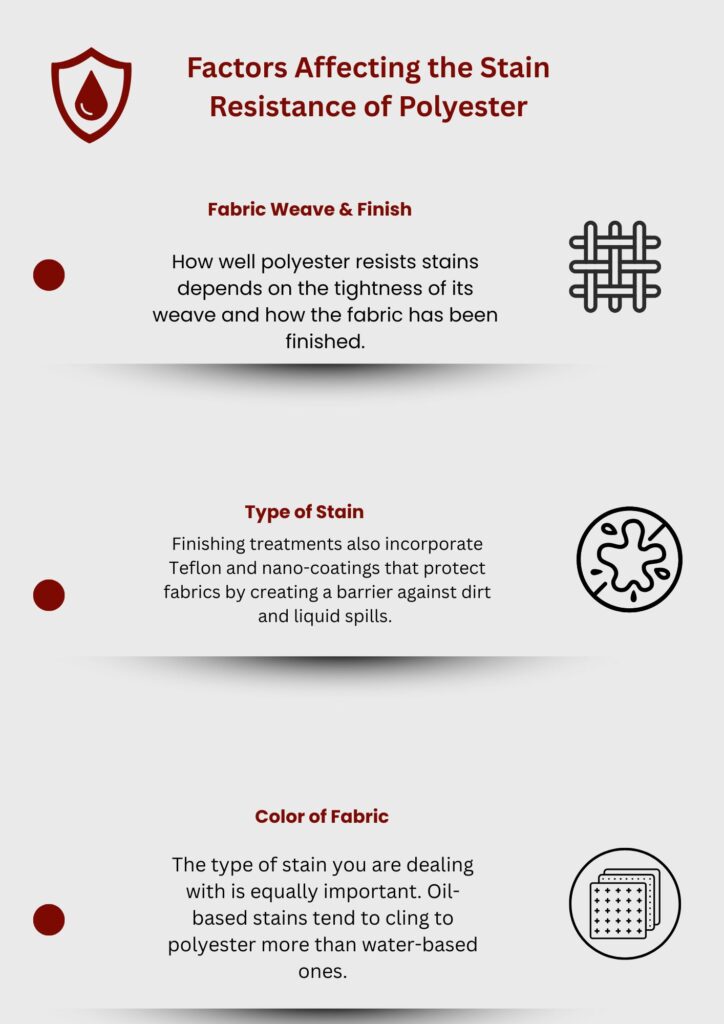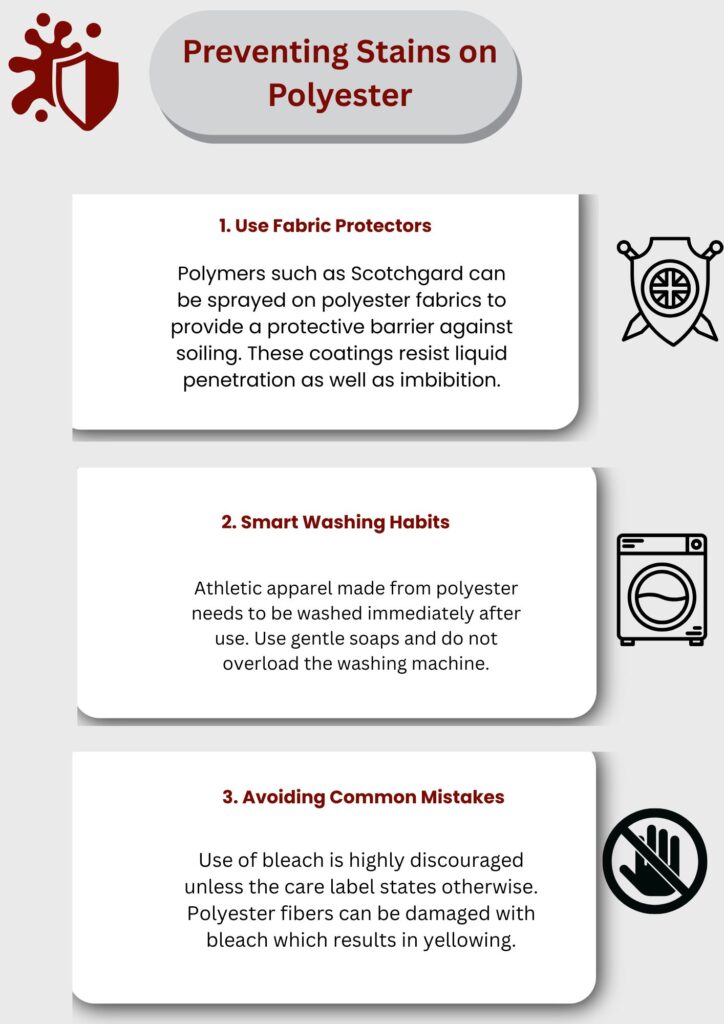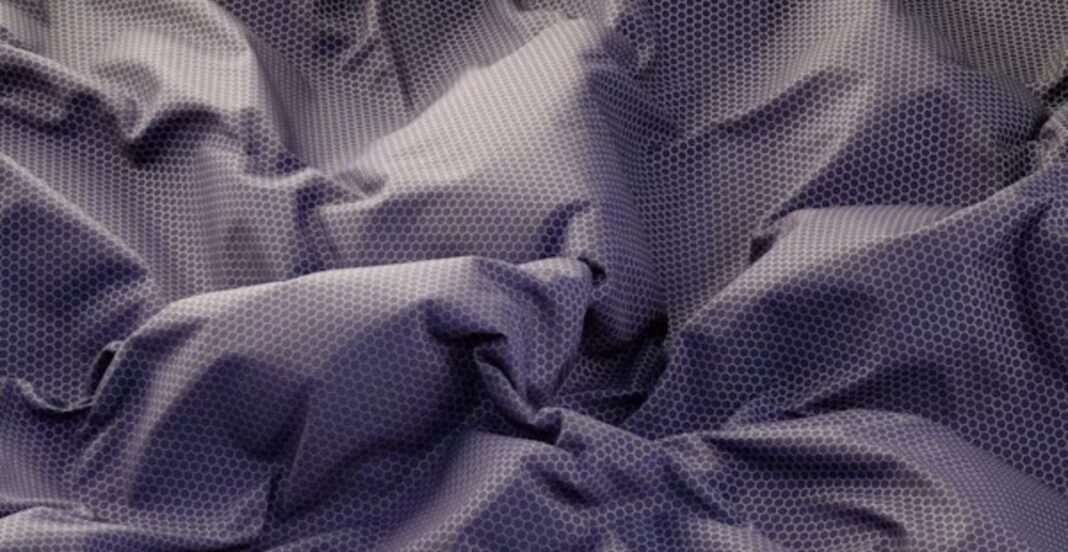Introduction
Polyester is a type of synthetic fabric which is extensively utilized in clothing, upholstery, bedding and other accessories. It is produced from oil by products and its strength and durability makes it one of the most sought after synthetic fabrics. In recent decades, polyester has gained traction for being one of the most affordable fabrics available in the market.
For a majority of consumers, resistance to staining is a decisive feature. A garment that becomes easily stained can become obsolete after one spill, while a stain resistant material is bound to withstand the test of time. This is where polyester can be especially useful. But does polyester easily stain? Let’s explore further.
Does Polyester Stain Easily? A Direct Answer
Putting it simply: polyester is stain resistant. In comparison with natural fibers, such as cotton or linen, polyester is considerably more resistant to stains. Its non-porous, synthetic fibers repel liquids more effectively and do not quickly absorb moisture.
Due to polyester’s lower absorbency, most water-based spills, such as coffee, take longer to absorb into the surface. This gives you time to remediate the stain before it solidifies. Polyester’s water-resistant properties, however, oil-based stains which may adhere to its fibers more aggressively. Stains aside, polyester offers maintenance convenience in comparison to most natural fabrics.
Factors Affecting the Stain Resistance of Polyester

1. Fabric Weave & Finish
How well polyester resists stains depends on the tightness of its weave and how the fabric has been finished. A ligneous weave on polyester fabrics makes it difficult for stains to penetrate. In addition, most polyester garments undergo finishings such as chemical treatments which are designed to make them stain resistant.
2. Type of Stain
Finishing treatments also incorporate Teflon and nano-coatings that protect fabrics by creating a barrier against dirt and liquid spills. Higher quality polyester garments are less prone to staining due to their looser weaves which absorb less dirt and impurities.
3. Color of Fabric
The type of stain you are dealing with is equally important. Oil-based stains tend to cling to polyester more than water-based ones. Juice and wine, which are water-based stains, initially rest on the surface of polyester, making it easier to blot.
Having an idea of the type of stain helps in choosing a cleaning method. While some dirt need instant attention, others require specialized cleaning treatment.
Common Stains on Polyester & How They Behave
1. Oil & Grease Stains
Oil and grease are particularly difficult to remove from polyester. Since polyester is a synthetic textile and water repellent, oil molecules have an affinity forBodies with grease also tend to stain or concentrate if they’re nottube not properly through methods that allow fabric spotting .
Routine attempts at combating stains from food or machinery is futile for oil stains are far too reliant on pre treatment methods that remove oils for polyester fabrics to be cleaned successfully .
2. Sweat & Deodorant Marks
Due to widespread use of polyester as an activewear material, the accumulation of sweat with deodorants is an everyday occurrence. Eventually this leads to the formation of yellowing and/or dull patches throughout the garment, especially under arms and necklines .
This type of staining may be slow to develop, butrhough it can be stubborn upkeep separately. Accumulating fabric grease especially becomes a problem if clothing is not thoroughly scrubbed while in hot water immersion basins between each wear and dry cycle.
3. Food & Drink Stains
Food spills such as sauces, coffee, or wine can seep into the fabric if not dealt with immediately. While polyester resists immediate absorption, blotted stains can become set as they dry.
Stains are more likely to become permanent the longer they are left on the surface. In the case of polyester, prompt blotting and cold water rinsing minimize damage.
4. Ink & Dye Stains
Ink and dye stains bond readily to polyester and become extremely difficult to treat. This category includes pen inks, printer inks, or even color transfer from other garments during laundering.
These stains have the potential to irrevocably change the color of polyester unless aggressive stain treatment procedures using strong solvents or stain-removers are employed.
How to Remove Stains from Polyester: A Step-by-Step Guide
1. Pre-treatment Tips
Start by blotting the stain with a clean cloth; soaking up as much liquid as possible. Remember to avoid rubbing, as this will set the stain deeper. Further, do not pour hot water directly onto the fabric or place it in a dryer before treating the stain, as this will set it permanently.
2. Homemade Cleaning Solutions
The following are household items that can aid in effectively removing stains:
- If you can, flush the fabric under cold running water to remove the staining substance. Vacuuming carpets with a mounted water jet extractor can extract embedded soil and debris.
- Baking soda and Vinegar: Apply a paste of white vinegar and baking soda on the stained area. After letting it sit for fifteen minutes, rinse.
- Hydrogen peroxide (for whites only): This method works for stubborn stains, but be sure to test a small area first firstly.
Soft and gentle methods are provided with no use of strict measures.
3. Recommended Commercial Stain Removers
The following polyester stain removers are trustworthy and effective:
- OxiClean: Suitable for various stains.
- Shout Advanced Gel: Works well on grease and oil stains.
- Zout: Best for sweat or food protein stains.
4. Washing Instructions
Use warm water for faint stains while cold water is effective against light discolorations. Avoid hot water since it sets stains. For delicate polyester blends, use a gentle cycle.
Always air-dry garments that are stained after washing. Do not dry those items until you are sure the stain is gone. Drying can set heat-activated bonds between the stain and the fabric.
Preventing Stains on Polyester

1. Use Fabric Protectors
Polymers such as Scotchgard can be sprayed on polyester fabrics to provide a protective barrier against soiling. These coatings resist liquid penetration as well as imbibition.
To maintain effectiveness, reapply after a few washes. Always perform a test on an inconspicuous area first for discoloration due to the treatment.
2. Smart Washing Habits
Athletic apparel made from polyester needs to be washed immediately after use. Use gentle soaps and do not overload the washing machine.
Cycles run on cold water help avoid setting stains and help maintain the fabric’s finishes.
3. Avoiding Common Mistakes
Use of bleach is highly discouraged unless the care label states otherwise. Polyester fibers can be damaged with bleach which results in yellowing.
Avoid ironing any fabric that has not been washed yet since heat can set the stain into the fabric. It is best to treat and wash the fabric prior to using any heat.
Polyester vs. Other Fabrics: Stain Resistance Comparison
1. Polyester vs. Cotton
Cotton is highly absorbent, and so it stains easily and deeply. Polyester, being less absorbent, gives you more time to respond to spills. Cotton may respond better to hot water and tough stain treatments, however, it may be weaker to these approaches towards stains than polyester.
Here, the winner can easily be said to be polyester. Its superiority over cotton in stain maintenance and long-term care is unquestionable.
2. Polyester vs. Wool
Wool is delicate and requires special cleaning, as well as being prone to shrink or felt with improper washing. It is, however, naturally stain resistant due to a lanolin coating.
Wool is better in dry conditions with light stains compared to polyester. Otherwise, the latter continues to be the dominant fabric when it comes to ease of washing.
3. Polyester vs. Nylon
Both nylon and polyester are synthetic materials, although nylon absorbs moisture to a slight degree compared to polyester. This increases the risk of staining.
Both fabrics struggle with oils. However, while nylon is more prone to stains, polyester is less likely to hold onto water-based stains.
Myths About Polyester & Stains
As with any other fabric, claims of polyester’s indestructibility are naive. It is true that polyester is more difficult to stain than other fabrics. However, claims that “polyester never stains” are myth.
Polyester does repel water, but it attracts and holds oil which is why it still requires thorough cleaning, giving rise to the myth that liquids repel polyester.
Lastly, some believe that polyester can withstand bleach. The truth is it depends on the dye and fabric blend, so never use bleach products without checking the label.
Conclusion
In conclusion, polyester is much less prone to staining when compared to natural fabrics. Its synthetic nature enables polyester to withstand most common stains. However, due to polyester’s chemical structure, oil-based stains can be problematic.
To keep your polyester clothing in excellent condition, use quick pre-treatments, select appropriate cleaning agents, and apply fabric protectors. Being knowledgeable on stain causes and removal helps you take charge.
With smart care for garments, polyester really can be a practical, stylish, and low-maintenance addition to any wardrobe.
FAQs
No, it does not. Polyester, unlike cotton, absorbs moisture at a lower rate which makes it less susceptible to staining. On the other hand, cotton absorbs moisture and can deeply stain.
Polyester is notorious for difficult to remove stains. Greasy marks stick firmly due to polyester’s oleophilic properties, the fact that it attracts and retains oils.
Only if the care label permits it. Some polyester fabrics will lose color, or be weakened by bleach.
Soak in a blend of vinegar, baking soda, and mild detergent. A commercial stain remover, such as OxiClean, would work as well.


